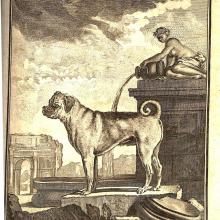
William & Mary Libraries recently acquired an 1805 edition of Ferdinand Seidel’s Naturhistorisches Kupferwerk: mit erklärendem Texte nach Büffon, or “Natural History in copper plates, with explanatory text following Buffon.” The edition is the only one in the U.S. and one of three in the world belonging to a library, according to WorldCat’s global library catalog.
Not only very rare, it appears the edition has had several owners closely connected to the court of Crown Prince Ferdinand of Denmark in the 19th century.
“The book bears the signatures of G. Muller and E. Bodenhoff. During research conducted as part of the cataloging process, we found that Muller and Bodenhoff are most likely General Frederik Gotthold von Müller and Ernst Emil Bodenhoff, both of whom were connected to the royal court of Denmark, Mueller as courtier and Bodenhoff as his biographer,” said archivist Ute Schechter. Schechter credits Ellen Cloyed, library specialist in the cataloging department, for her diligent work in tracing the ownership.
Unlike Buffon’s ten-volume standard scientific work, Seidel’s one volume (the originally planned second volume was never published) intended to reach a more general audience: lovers and amateurs of natural history, as well as juveniles. Newspaper advertising and reviews emphasize that the heavily illustrated volume would both educate and entertain.
“Given that there are more copperplate engravings – 179 – than pages of explanatory text –155, Seidel was likely right on track to achieve that goal,” said Schechter.

Reviews praise the quality and quantity of the illustrations, though at least one reviewer would have preferred if Seidel had copied not the black & white ‘Buffon-style’ illustrations but instead had chosen illuminated copperplates.
Nevertheless, the artists and engravers of Seidel’s natural history volume were well-known men, like Jacques de Sève, Jean-Baptiste Oudry, Johann Martin Bernigeroth – and maybe more surprisingly, at least one women: Johanna Dorothea Phillip, who had learned the art of copperplate engraving from her father, Johann Christoph Sysang.
“Now more than 200 years after Seidel’s Natural History was first published, the library is doing its part to assure the enduring value of the volume, so it can continue to fulfill the author’s mission to educate and entertain,” said Schechter.
Library users can view the book in Swem Library's Special Collections Research Center. For more information, contact spcoll@wm.edu.

